Alfred D. McKelvy (Seaforth)
In the late 1930s, Alfred Douglas McKelvy began developing a male cosmetic line. Exactly when is unclear but it may have been as early as 1935. In 1938, he founded the Alfred D. McKelvy Company in Minneapolis, Minnesota and the Seaforth line of men’s toiletries made its first appearance the following year.
After graduating from Princeton University in 1924, McKelvy had been employed as a salesman in a number of different Kansas City firms including Midland Flour Milling, Town Crier Food Products, and American Vending Machines. Later still, he gained employment with the Russell C. Comer Advertising Agency, also based in Kansas City.
McKelvy’s new business was something of a gamble but he was probably encouraged by the success of Shulton’s Early American Old Spice range for men, first introduced in 1938. When he went on the road with sample containers of Seaforth eliciting orders from department stores such as Marshall Field (Chicago), B. Altman (New York), Saks (New York), Joseph Horne (Pittsburg), and Strawbridge & Straus (Philadelphia), McKelvy’s task was made easier by the fact that Shulton’s men’s lines had proven to be highly profitable.
See also: Shulton
Seaforth followed the Shulton model in a number of ways. First, like Shulton, the Seaforth range included a shaving mug, after-shave lotion, cologne, talcum, and soap but soon added a deodorant and then a hair dressing (1941) containing Tanniform, a type of tannic acid that acted as a scalp stimulant. Second, McKelvy also looked to the past to find his marketing inspiration selecting the Seaforth Highlanders, a British regiment established in 1881, for the product name and image. He also used ceramic containers for his liquid product. In his case these were based on whisky jugs. Third, he priced individual Seaforth lines at US$1.00, the same as Shulton.
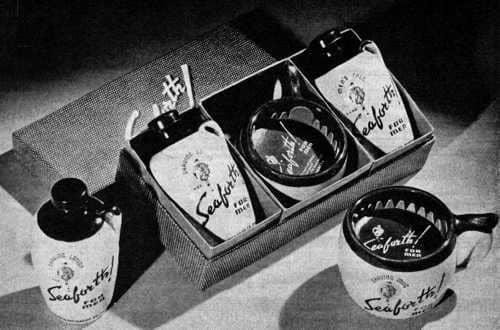
Above: Seaforth products. Liquid containers in the range were based on Scotch whisky jugs – stoppered with a resealable plastic cap rather than the traditional cork and wax – while the shaving mugs were made to look like sac cups used for warming wine. Most products were packaged in cardboard boxes decorated with a brown and white tweed pattern.
The scent chosen for the range was going to be crucial if men were to continue to use the products so a good deal of time and effort was put into selecting the original fragrance. This was originally called Heather and Fern or Heather ’n Fern. In 1954, this became Scotch Heather and the following year simply Heather.
Many hours were spent in experimenting with various combinations of these three odors [heather, fern and peat moss] and dozens of them were thrown aside … but out of these experiments came nine blends that pleased. … He arranged with a telegraph company to place the odors, labelled with a key letter, in several large receiving offices. Men sending telegrams were asked to indicate their choice. Out of several thousand votes cast, a decided preference was shown for one odor—a preference greater than for all other odors combined—and that odor became Seaforth.
(Frederic, 1945, p. 48)
Seaforth products were sold individually and in a range of gift packs. The latter was essential as most Seaforth toiletries – and men’s toiletries in general – were bought by women as presents for Christmas or Father’s Day.
Vick Chemical Company
Seaforth’s success brought with it some problems. The company was short of the capital needed for expansion and this was the main reason it sold out to the Vick Chemical Company in 1941.
In the 1940s, Vick Chemical was undergoing a program of diversification it had started in 1938. Its purchase of the Alfred D. McKelvy Company in August, 1941, reputedly for US$500,000, was one of a number of acquisitions it carried out in that year, the others being Prince Matchabelli, Inc., the J. T. Baker Chemical Company and Loeser Laboratory, Inc.
See also: Prince Matchabelli
Joining Vick gave the Alfred D. McKelvy Company access to large manufacturing facilities, an established distribution network, and a bigger advertising budget. By late 1941, Seaforth was being produced in factories in Minneapolis, Los Angeles, and Mexico City, and its products were available in 17 countries (AP&EOR, September 1941, p.75).
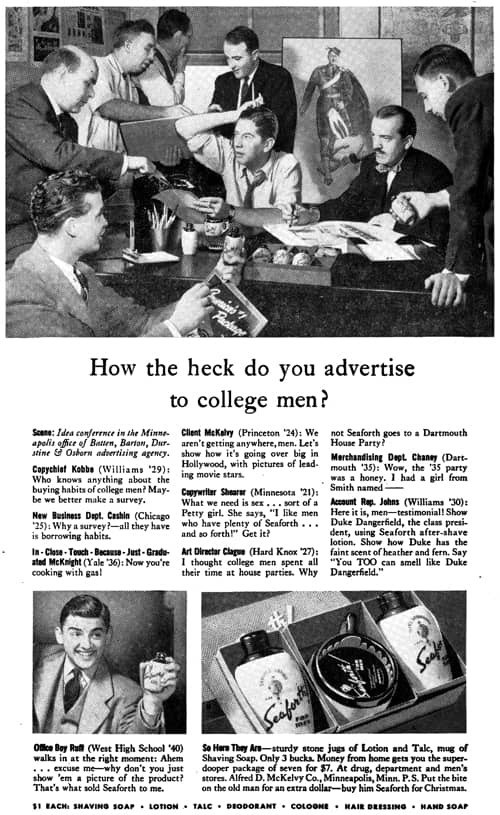
Above: 1942 Seaforth advertisement in the ‘Daily Princetonian’ depicting a meeting at Batten, Barton, Durstine & Osborn, the advertising agency who handled the McKelvy account. Alfred D. McKelvy has been superimposed into the scene.
Alfred D. McKelvy continued on as president of the company after its purchase by Vick Chemical but, in October, 1942, the headquarters of the company were moved to 10 Rockefeller Plaza, New York and manufacturing was relocated to Greenwich, Connecticut.
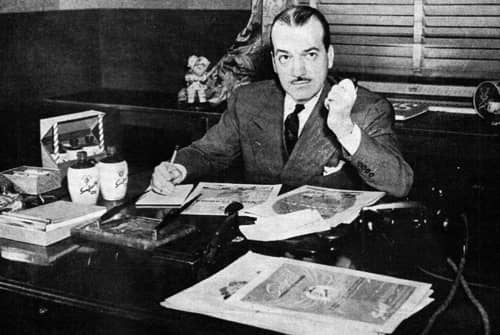
Above: 1945 Alfred D. McKelvy during his time at Vick Chemical.
America’s entry into the Second World War in December, 1941 started a boom in men’s toiletries. The movement of large numbers of men into military service required many of them improve their level of grooming. It also saw a rise in the purchase of men’s toiletries by women who sent them to their loved ones away on service and companies producing men’s toiletries added suitable gift sets.
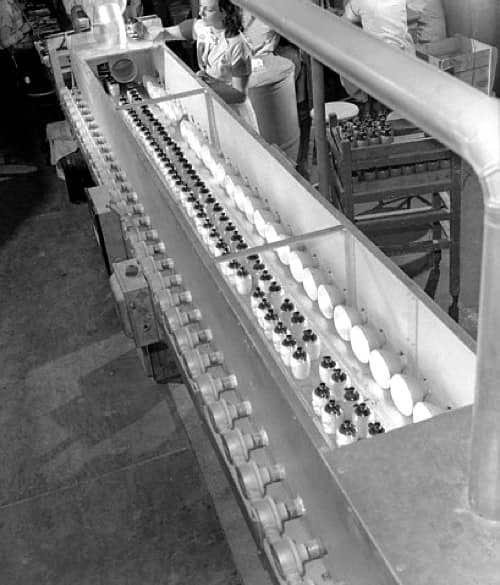
Above: 1946 Seaforth products being manufactured.
By 1946, Vick Chemical had twelve different gift sets in the Seaforth range and its profits from Seaforth offset some of its reduced returns created by the loss of its European and other markets cut off by the war.
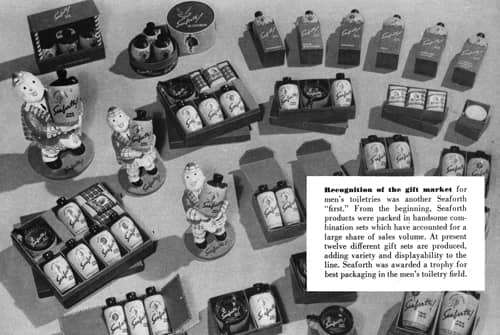
Above: 1946 Seaforth range.
McKelvy left Vick Chemical after the war and moved on to other pursuits. It seems likely he was not suited to corporate culture. His departure was followed by some rationalisation at Vick Chemical as men’s toiletries became an increasingly crowded market and advertising expenses rose through greater use of television. In 1949, the Prince Matchabelli and Seaforth sales teams were combined and, in 1956, the two separate organisations were combined into the Matchabelli-Seaforth division based at 415 Madison Avenue, New York.
Vick Chemical continued to introduce new product lines into the Seaforth range including: Brushless Shave Cream (1947); Groomstick, a stick after-shave lotion (1951); Presto-Lather shave cream (1952); Stāvo spray deodorant containing ‘Chlorotex’, made from chlorophyll (1952); Seaforth Solid Deodorant also containing ‘Chlorotex’ (1953); Spiced Shave Lotion, with a new ‘spicy’ fragrance (1953); and Pre-Lim Electric Shave Aid (1955).
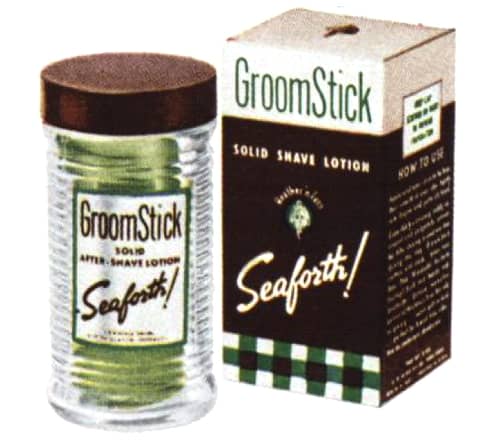
Above: 1951 Groomstick Solid After-Shave Lotion.
In 1953, in an effort to improve its margins on men’s toiletries, the company introduced a more up-market product range – consisting of a shaving lotion, cologne and combination set – distinguished by a new fragrance called Black Watch, named after another highland regiment. To give the product an air of exclusivity its distribution was restricted to ‘better’ outlets.
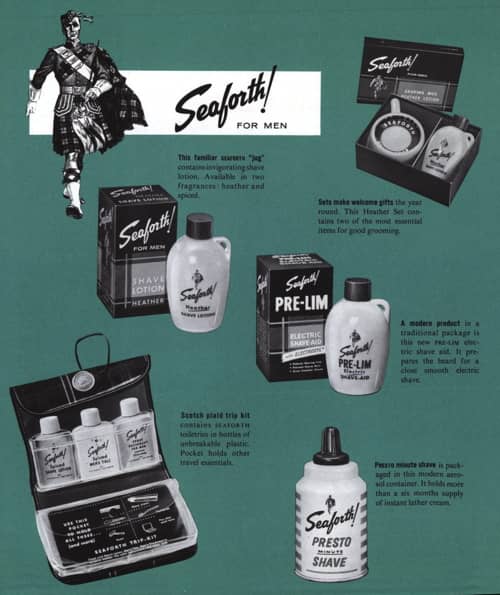
Above: 1955 Seaforth products.
As the competition for men’s and women’s cosmetics increased during the 1950s, and Vick Chemical’s sales of these lines began to plateau, the company began to rethink its business plan. Deciding to concentrate of drugs, chemicals and plastics, where it was still showing appreciable levels of growth, it sold its cosmetics businesses to Chesebrough-Pond’s in 1958.
Chesebrough-Pond’s
The acquisition of Vick Chemical’s cosmetic businesses included Prince Matchabelli, McKelvy (Seaforth and Black Watch), Polyderm and Sofskin – a company Vick Chemical had bought in 1946.
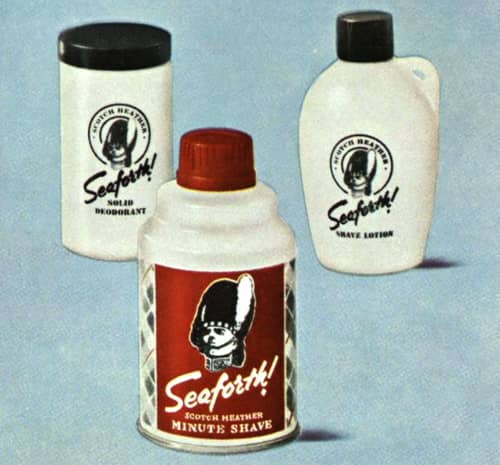
Above: 1959 Chesebrough-Pond’s Seaforth lines: Solid Deodorant, Scotch Heather Minute Shave, and Shave Lotion.
The Seaforth line was reorganised and streamlined, products with poor sales were eliminated and sizes, packaging, and prices were standardised. The number of seasonal gift packages was also reduced. Then, in 1961, Chesebrough-Pond’s put Black Watch into its new Prince Matchabelli Division, after which it sold off the Seaforth part of McKelvy to Mary Chess in 1962.
See also: Chesebrough-Pond’s
Nestle-LeMur
Seaforth was acquired by Nestle-LeMur from Mary Chess in 1964. Nestle-LeMur owned a number of cosmetic lines including Yu, Club, and Napoleon men’s toiletries by Pinaud. New fragrances were introduced into the Seaforth range including: Sea Spice Lime (1966); Scotch Leather (1968); and Dominican Bay Rum (1968) but little else was done to the range. Over time the Seaforth product line appears to have been reduced down to after-shaves as Nestle-LeMur concentrated more on its Clubman line of men’s toiletries.
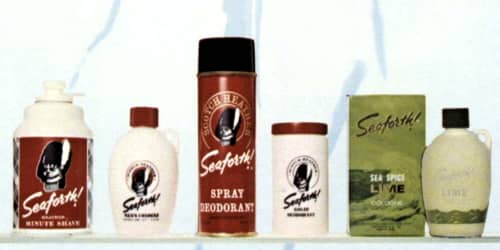
Above: 1966 Nestle-LeMur Seaforth lines: Heather Minute Shave, Cologne, Spray Deodorant, Solid Deodorant, and Sea Spice Lime.
Seaforth after-shave was still available in 1981 but seems to have disappeared sometime during that decade.
Timeline
| 1938 | Alfred D. McKelvy Co. founded. |
| 1939 | New Products: Seaforth line. |
| 1941 | Vick Chemical Company acquires the Alfred D. McKelvy Company. New Products: Seaforth Hair Dressing. |
| 1942 | Company headquarters moved to 10 Rockefeller Plaza, New York; factory moved to Greenwich, Connecticut. |
| 1947 | New Products: Brushless Shave Cream; and Royal Scot Set in unbreakable Duralite containers. |
| 1949 | Prince Matchabelli and Seaforth combine sales teams. New Products: Duo Box Set; and Stud Box Set. |
| 1950 | New Products: Hook ’n Lather Set. |
| 1951 | New Products: Groomstick, a solid after-shave lotion. |
| 1952 | New Products: Veladron Brushless Shave Cream; Presto-Lather Shave Cream; and Stāvo spray deodorant. |
| 1953 | New Products: Spiced Shave Lotion; and Black Watch line. |
| 1955 | Seaforth repackaged in red and green. New Products: Pre-Lim Electric Shave Aid. |
| 1956 | Vick combines Seaforth and Matchabelli into the Matchabelli-Seaforth division based at 415 Madison Avenue, New York. New Products: Scotch Heather fragrance. |
| 1958 | Vick Chemical Company sells Prince Matchabelli to Chesebrough-Pond’s. |
| 1961 | Black Watch added to the Prince Matchabelli Division. |
| 1962 | Mary Chess acquires Seaforth from Chesebrough-Pond’s. |
| 1964 | Nestle-LeMur buys Seaforth from Mary Chess. |
| 1966 | New Products: Sea Spice Lime fragrance. |
| 1968 | New Products: Scotch Leather fragrance; and Dominican Bay Rum fragrance. |
First Posted: 27th June 2016
Last Update: 8th April 2022
Sources
The American perfumer & essential oil review. (1906-1955). New York: Robbins Perfumer Co. [etc.].
Chesebrough-Pond’s, Inc. Annual Reports 1962-1964.
Frederic, W. (1945). Success story: Seaforth cosmetics. The American Perfumer & Essential Oil Review, March, 47-49.
Vick Chemical Company, Inc. Annual Reports 1941-1957.
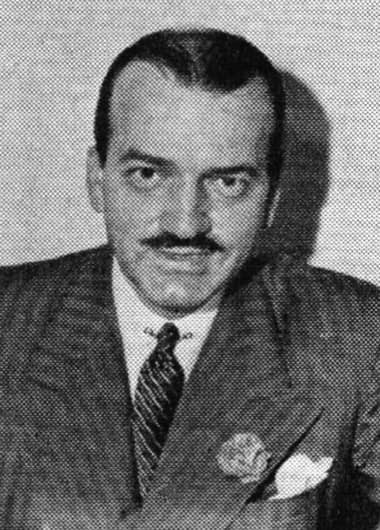
Alfred Douglas McKelvy [1901-1984]. Born in Atchinon City, Kansas in 1901, he was the third of four children of William Addison McKelvy [1858-1935], a dentist, and Eleanor McKelvy née Cain [1869-1961]. After leaving Vick Chemical, McKelvy moved to California with his second wife Doryce Katheryn McKelvy née Kellerman [1923-2004] where they became involved in a number of business projects including instant foods, real estate and the McKelvy Oil Company.
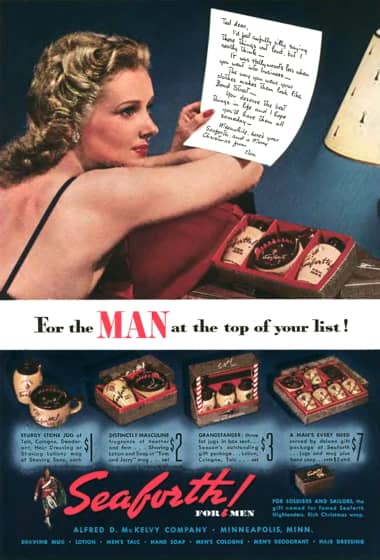
1941 Seaforth. Each product was priced at a multiple of US$1.00. Round sums were selected because McKelvy thought men did not like to wait for change (AP&EOR, September 1941, p. 75).
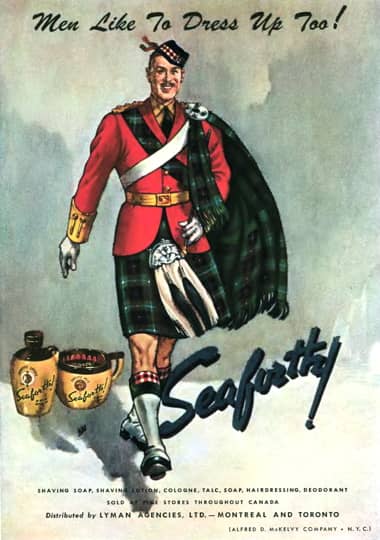
1943 Seaforth.
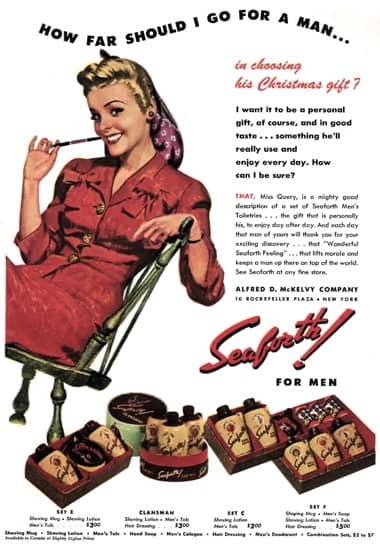
1943 Seaforth gift suggestions for Christmas.
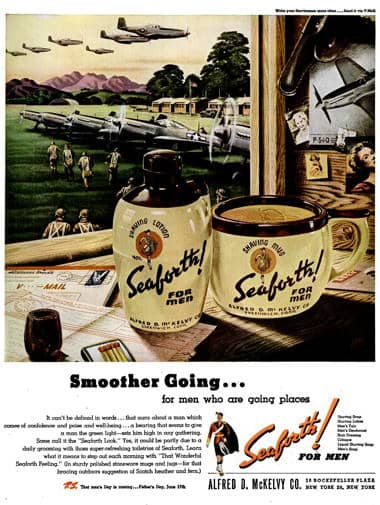
1945 Seaforth.
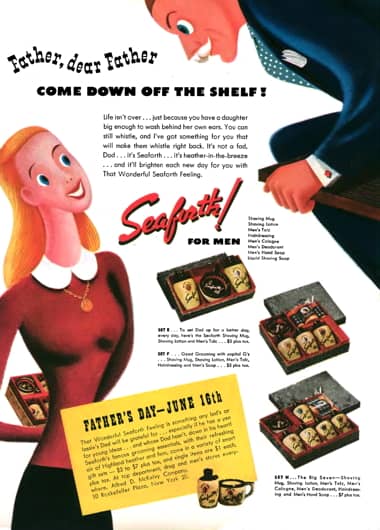
1946 Seaforth gift suggestions for Father’s Day.
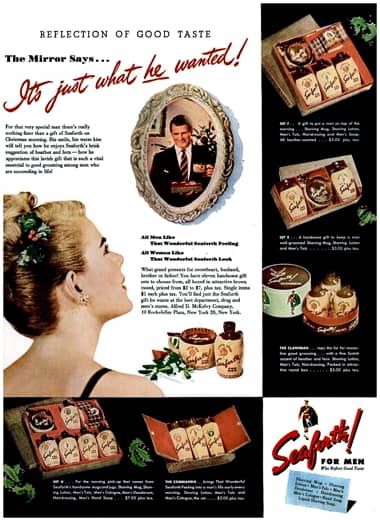
1946 Seaforth.
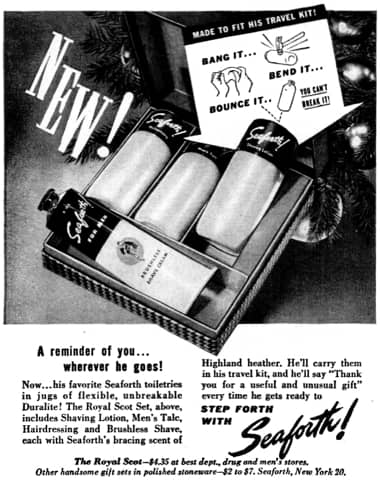
1947 Seaforth Royal Scot Set. This travel set contained Shaving Lotion, Men’s Talc and Hairdressing in unbreakable Duralite as well as a tube of Brushless Shave Cream.
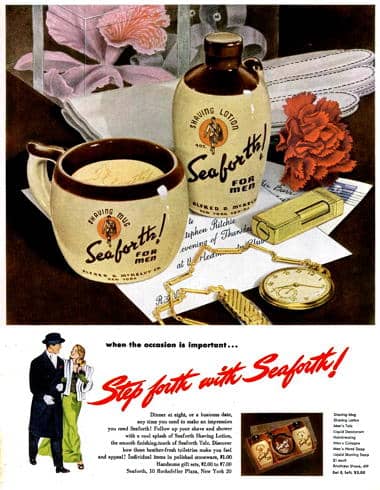
1947 Seaforth.
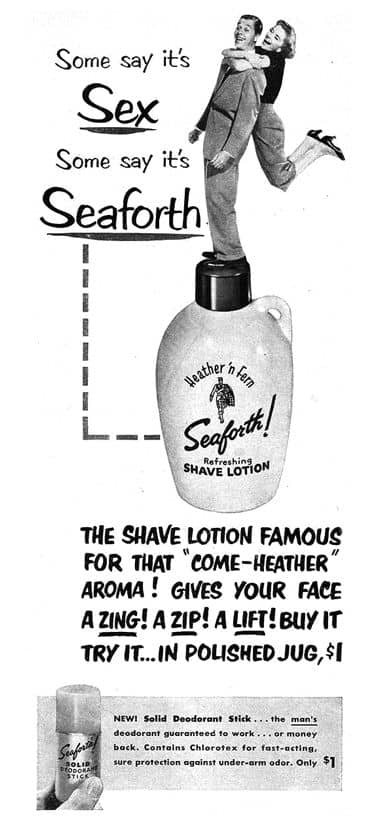
1953 Seaforth Shave Lotion and Seaforth Deodorant Stick with Chlorotex
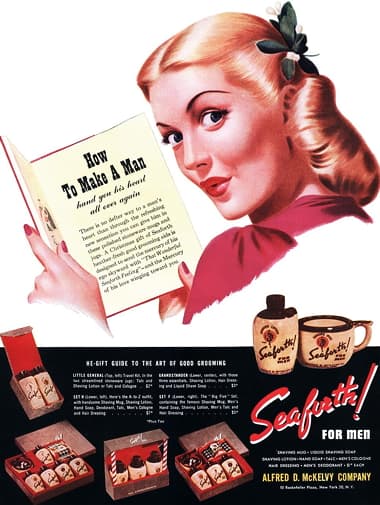
1954 Seaforth.
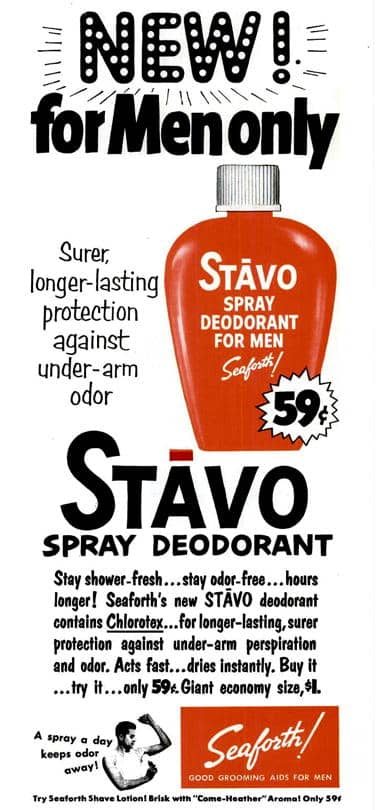
1955 Seaforth Stāvo Spray Deodorant. The product was sold in a polythene squeeze pack similar to that introduced by Stopette in 1947. The colour red was added to the packaging in the rest of the Seaforth range in 1955.
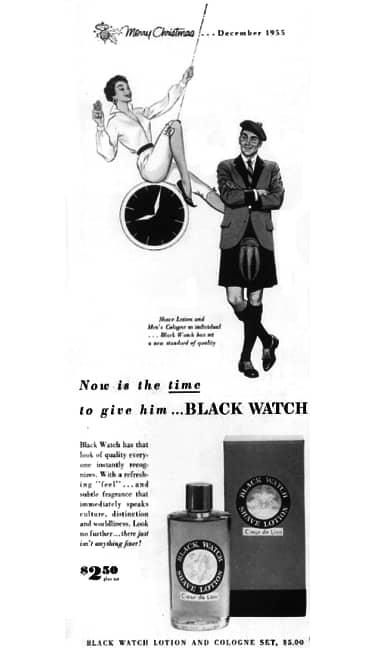
1955 Black Watch. Chesebrough-Pond’s would separate Black Watch from Seaforth in 1961 and thereafter it would be referred to as a Prince Matchabelli line.
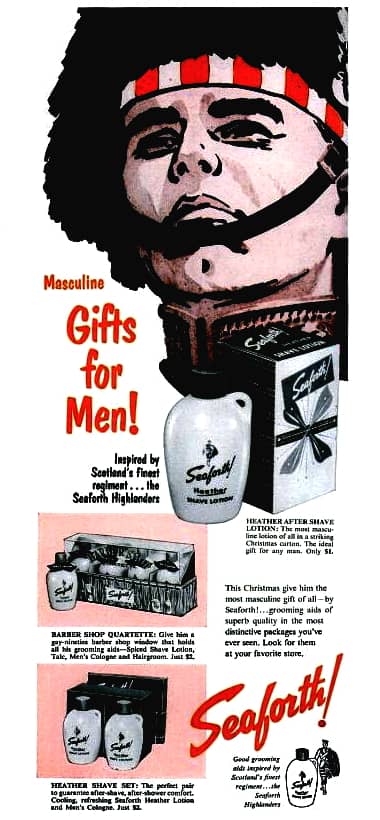
1956 Seaforth.
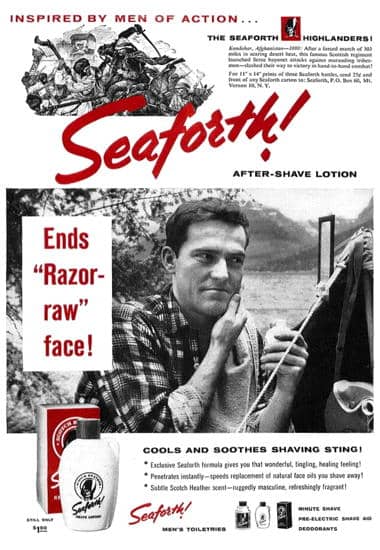
1960 Seaforth now owned by Chesebrough-Pond’s.
